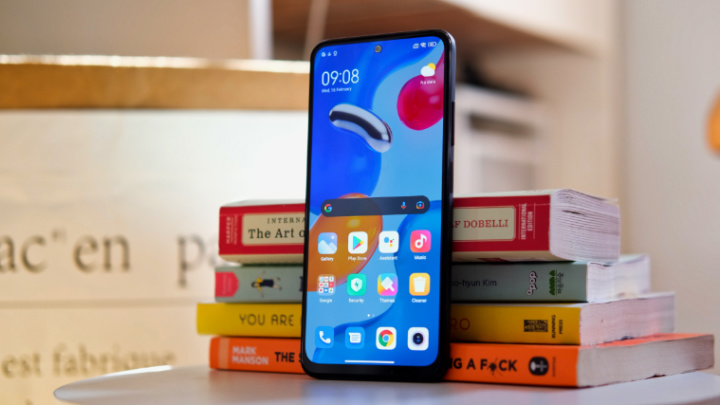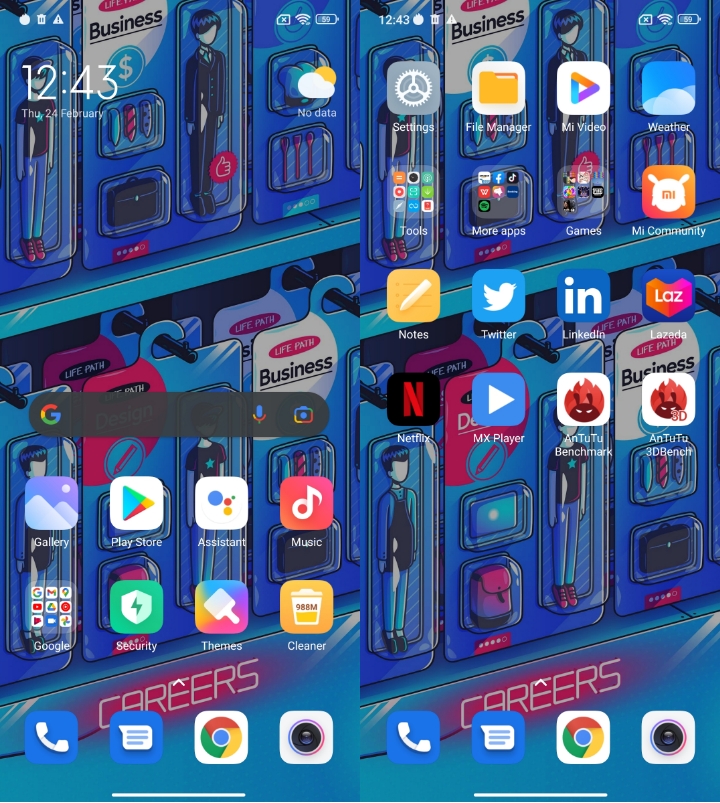Xiaomi recently released three new smartphones under the Note family. One is the Redmi Note 11, which is the base model, the other is the Redmi Note 11 Pro 5G. Sitting in the middle is the Redmi Note 11S. With its 6.43-inch AMOLED screen with 90Hz refresh rate, Helio G96 SoC, and 108MP quad-rear cameras, how does it perform compared to its siblings? Find out in this review.
Table of Contents

The Redmi Note 11S looks just like its siblings. They even have the same dimensions. You got a large 6.43-inch display with a punch-hole for the 16MP selfie camera. Above it is the earpiece for calls.

Placed at the top is the 3.5mm audio jack, the loudspeaker, IR blaster, and a microphone.

To the left, we have the card tray for two nano-sized SIM cards and a microSD card.

On the right, there are the volume buttons and the flat power/lock button that also doubles as a fingerprint scanner.

At the bottom, we have the USB-C port, microphone, and loudspeaker.

At the back, there’s the quad-camera module with the protruding main lens. As expected, it won’t lay even on the surface when you put it down.

As for its build, the Note 11S is a relatively tall device with a narrow frame. The sides of the frame are also flat to make it easier to grip even with its 8.09mm thick body. The frame is metallic, while the back panel has a frosted finish, which repels smudges and fingerprints well. Although I’d still recommend putting on the clear case to protect its body, especially that protruding camera. In addition, it can withstand dust and splashes of water with its IP53 rating.
The Redmi Note 11S has the same screen as the Redmi Note 11 at 6.43-inches with Full HD+ resolution or equal to 409ppi. It also uses an AMOLED screen with Corning Gorilla Glass 3 for protection.

It’s a vibrant screen with up to 1000 nits peak brightness. It’s got punchy colors and deep blacks which is great for dark mode. Those looking for smooth animations and transitions will like the 90Hz refresh rate with an option to bring it down to 60Hz to save battery. If you like playing games, the Redmi Note 11S also boasts a 180Hz touch sampling rate for better touch response than your conventional smartphone.
When it comes to audio, we’re glad to see dual speakers in smartphones in this price range. It’s crisp and loud, doesn’t have much bass, but it’s immersive and good enough for watching videos or playing games. You can either use your favorite wired headphones or go wireless and hook it up to a TWS or external Bluetooth speaker.
Like the Redmi Note 11, the Note 11S has four cameras. But Xiaomi gave this model an upgrade in the main camera and packs a 108MP sensor like the Note 11 Pro 5G. The rest is the same. There are the 8MP ultra-wide, 2MP macro, and 2MP depth sensors. For selfies, it also follows its Pro sibling with a 16MP shooter.

Quality is good for its class. The main camera can capture images with plenty of details, accurate colors, and a good dynamic range. The main sensor takes 12MP images by default, which is more than enough for uploading on social media. But if you want that 108MP full resolution, you’ll have to go to the shooting options and choose that mode. For the ultra-wide camera, it has a decent resolution, but the images produced seem to be on the cooler side and could use a bit of boost in contrast.
Selfies are good and have that wide angle for easy group selfies. It’s sharp, has nice colors, but is prone to noise. For better results, makes sure to shoot in bright locations. Check out the samples here.
For videos, the Redmi Note 11S can record at a maximum of 1080p at 30fps. It cannot transition, though, between the main camera and the ultra-wide lens, so you’ll need to stop recording and change cameras, which is cumbersome. Videos taken using the main camera are sharp with a good dynamic range. It also has stabilization which minimizes the shakes when we walk. Watch the sample below.
https://youtu.be/-8sCiDYU1Ts
Running the software side is MIUI 13 based on Android 11. It’s a visually pleasing interface with apps placed directly on the home screen and loaded with features like Cleaner, Security Scan, Game Turbo, App Lock, Dual apps, Second space, Hidden apps, Privacy protection, and ShareMe wireless transfer.

What is not pleasing, though, is the pre-installed apps like Amazon Shopping, Facebook, TikTok, WPS Office, 92, Booking.com, Spotify, and some games. While you can easily uninstall these apps, we still prefer not having to go through them.

Storage-wise, we have 128GB UFS 2.2 onboard, which is a decent storage space for a device of this caliber. If that is not enough for storing your files, you can expand it with a microSD card.
Powering the Redmi Note 11S is a 12nm MediaTek Helio G96 SoC with two 2.05GHz Cortex-A76 cores and six 2.0GHz Cortex-A55 cores. For the GPU, it has a Mali-G57 MC2. The RAM is at 8GB with the capability to extend an extra 3GB using the phone’s storage.

It’s a very capable configuration and was able to keep things running smoothly. Apps launch fast and multitasking is a breeze. We didn’t encounter any hiccups while using any of the phone’s built-in apps or features, including popular social media apps from the Play Store.
When it comes to gaming, we ran Genshin Impact and its default graphics settings is Lowest. But we placed it in Highest and bumped the framerates to 60 and it was very much playable. It’s not the smoothest experience, though, as we encounter freezing frames from time to time, but not that bad to ruin the experience. Warming can be felt at the back beside the cameras but is not uncomfortable.

Check out the benchmarks below:
• AnTuTu v9.3.1 – 315,191
• AnTuTu Storage Test v9.3.1 – 25,460, 505.9 MB/s (Seq. Read), 455.2 MB/s (Seq. Write)
• Geekbench 5 – 529 (Single-Core), 1,843 (Multi-Core), 1,411 (OpenCL)
• PC Mark – 8,596 (Work 3.0)
• 3D Mark – 1,089 (Wild Life), 320 (Wild Life Extreme)
The Redmi Note 11S got your basic connectivity features and then some. There’s dual-SIM, 4G LTE, WiFi ac, Bluetooth 5.0, NFC, IR Blaster, GPS, USB-C, and a 3.5mm audio jack. There’s no 5G, which is reserved for the Pro variant. It’s not a big deal unless you really need that 5G.
For the battery, we have the same from the Note 11, which is 5,000mAh. PC Mark’s battery test rated the battery life at 15 hours and 21 minutes, while our video loop test, which involves playing a 1080p video on loop at 50% brightness in Airplane mode, and we got 21 hours and 15 minutes of playback, which is good. The 33W fast charging, on the other hand, can replenish it in a little over an hour.
The Redmi Note 11S is positioned quite well among the Note 11 series. It’s like an upgraded version of the Note 11, sporting a powerful chipset that performed better in AnTuTu, a higher main camera resolution, a higher front camera resolution, bigger RAM, and longer battery life.

Xiaomi, however, is yet to reveal the price of the Redmi Note 11S. Considering that the Redmi Note 11 6GB + 128GB is already at PHP 9,999USD 170INR 14,445EUR 162CNY 1,241, we can expect the 11S to be more expensive. Is it worth getting? If the advantages mentioned above is what you’re looking for and if it’s priced attractively, then the answer is yes.
Xiaomi Redmi Note 11S specs:
6.43-inch FHD+ (2400 x 1080) AMOLED display
90Hz refresh rate, 180Hz touch sampling rate
Corning Gorilla Glass 3 front
MediaTek Helio G96 SoC
Mali-G57 MC2 GPU
6GB, 8GB LDPRR4X RAM
64GB, 128GB UFS 2.2
microSD support (dedicated)
Quad-rear cameras:
• 108MP F1.9 main
• 8MP F2.2 ultra-wide
• 2MP F2.4 macro
• 2MP F2.4 depth
16MP F2.4 front camera
Dual-SIM
4G LTE
WiFi 802.11 a/b/g/n/ac
Bluetooth 5.0
NFC
IR blaster
GPS, A-GPS, GLONASS, BDS, GALILEO
Fingerprint scanner (side)
USB-C
Dual speakers
3.5mm audio jack
IP53 splash-proof
MIUI 13 (Android 11)
5,000mAh battery w/ 33W fast charging
159.87 x 73.87 x 8.09 mm
179 g
Graphite Gray, Twilight Blue, Pearl White
Error: Unable to fetch products (Status: 403)

YugaTech.com is the largest and longest-running technology site in the Philippines. Originally established in October 2002, the site was transformed into a full-fledged technology platform in 2005.
How to transfer, withdraw money from PayPal to GCash
Prices of Starlink satellite in the Philippines
Install Google GBox to Huawei smartphones
Pag-IBIG MP2 online application
How to check PhilHealth contributions online
How to find your SIM card serial number
Globe, PLDT, Converge, Sky: Unli fiber internet plans compared
10 biggest games in the Google Play Store
LTO periodic medical exam for 10-year licenses
Netflix codes to unlock hidden TV shows, movies
Apple, Asus, Cherry Mobile, Huawei, LG, Nokia, Oppo, Samsung, Sony, Vivo, Xiaomi, Lenovo, Infinix Mobile, Pocophone, Honor, iPhone, OnePlus, Tecno, Realme, HTC, Gionee, Kata, IQ00, Redmi, Razer, CloudFone, Motorola, Panasonic, TCL, Wiko
Best Android smartphones between PHP 20,000 - 25,000
Smartphones under PHP 10,000 in the Philippines
Smartphones under PHP 12K Philippines
Best smartphones for kids under PHP 7,000
Smartphones under PHP 15,000 in the Philippines
Best Android smartphones between PHP 15,000 - 20,000
Smartphones under PHP 20,000 in the Philippines
Most affordable 5G phones in the Philippines under PHP 20K
5G smartphones in the Philippines under PHP 16K
Smartphone pricelist Philippines 2024
Smartphone pricelist Philippines 2023
Smartphone pricelist Philippines 2022
Smartphone pricelist Philippines 2021
Smartphone pricelist Philippines 2020